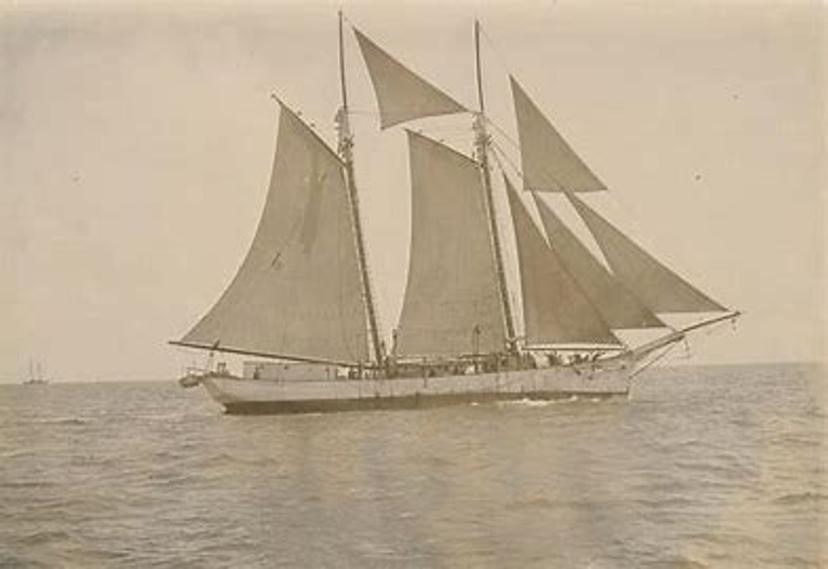Captain Davies
Vessel Name: Pearl
Captain Davies
Died aboard; buried en route
15 November 1885

Pearl
Following the deaths of Captain James Rickinson and mate Challoner Shenton in 1885 at the hands of attacking Nimanburu men, the schooner Pearl was under the command of John Wood by order of the Government Resident until the inquiry into the deaths was complete and probate was finalised for the deceased. [See the Rickinson and Shenton story].
The boat owners WS Findlay and RB Baynes had £2400 of pearl shell aboard the boat while John Woods was the master of Pearl and her fleet. Owners Findlay and Baynes were angry at the Government Resident’s decision. They had a new captain and mate selected for the Pearl. John Wood resorted to commencing court proceedings when the owners refused to pay him. The Supreme Court jury awarded him a total of almost £500.
In September, the Pearl and her fleet of six luggers was released back to the owners, and they appointed Captain Davies and mate Ernest Fox to command their pearling fleet. According to John Wood, Captain Davies was a drunkard, and Ernest Fox had little experience in pearling. John stayed with the Pearl until the end of October to aid the captain and the mate to find their feet in command of the pearling outfit.
Pearl was the mother boat for the fleet, and had divers, tenders and pump hands. She was a 30 ton two-masted ketch with schooner rigging. She was not registered in Fremantle until 1873, although she was built in 1870 by Charles Watson in Fremantle. Her official number was 61111. She was 57 feet long, 18 feet wide and drew 7 feet of water.
Captain Davies took command of Pearl in the pearling grounds from the end of October 1885. It was not long before it became apparent the captain was not a well man. The fleet was at King Sound near Derby when he became too unwell to command.
The captain had erupting sores on his legs and what was described as “apoplectic fits” or acute disruptions of blood to the brain in the months prior to being bed-ridden.
Upon realising Captain Davies was growing worse, and was no longer able to command, the mate Ernest Fox took command and headed to Derby to provision for Port Darwin, where the Pearl was based at the start of each season. They started out on 11 November in good weather with fair winds.
The captain died on 15 November. The nearest place to anchor was Condillac Island, which they reached at 5pm. The crew made a coffin. They cautiously stood guards with firearms, for fear of an attack by local natives.
Captain Davies was buried on the island the next morning. The Pearl continued the voyage to Port Darwin to report his death to the authorities on their arrival on 24 November.
On her way to Port Darwin, the Pearl came across the mate and a crew of seven from the Berleaux which had burnt to the water line at Browse Island. Berleaux had been loading guano at the island. Guano is rich in nitrogen and phosphorus, so when it is heated up, it smoulders and can cause fires and explosions – dangerous for wooden vessels. They were adrift in a small open boat. Pearl picked up the crew and carried them safely to Port Darwin.
In general, 1885 was an unfortunate year for the Pearl, and she was gaining a reputation as an “unlucky” boat. Fortunately, her crew of Malay pump hands and tenders and Japanese divers were catching a great deal of pearlshell, and so they did not desert her. After the mate Challoner Shenton’s untimely death, the crew were a little relieved to have a fairer and less violent mate in command.
Ernest Fox was made the captain of the Pearl which was convenient since recent history had made the position undesirable. By 1887 Ernest was her owner, and she was an “apparatus diving boat” (used diving dress and air pipes). In 1888 Ernest ordered a new pearling vessel from WA Chamberlain in Fremantle.
Pearl survived the cyclone of April 1887, which decimated the northwest pearling fleet. Ernest Fox provided aid to stricken boats and related details of the storm and the vessels affected to newspapers. Pearl had left Port Hedland on 17 April and made for Banningarra Creek with two days of water on board. When the barometer dropped to 28 degrees, the crew close-hauled between Bedout Island and the Condon Banks. The wind veered from southeast to northeast and a wild sea was running. Three days later when the cyclone abated, the crew had been without fresh water for five days. Heading urgently for Banningarra Creek the crew were saved when they sighted the schooner Telephone, and were given water, which saved the crew. Pearl was losing her “unlucky” name and Captain Fox was proving to be a sound commander.
Later in 1887 Lieutenant Colonel Angelo, Government Resident of Roebourne was asked by the pearlers to visit the northwest and carry out the tasks of the inspector of Pearl Shell Fisheries. On the visit, he hoisted the revenue flag on the Pearl and Captain Fox took him to the fleets along the coast where he heard and dealt with cases between owners and crews, checked smuggling and illicit practices. This cemented the reputations of Captain Fox and the Pearl among the boats in the Port Darwin to King Sound fleet.
